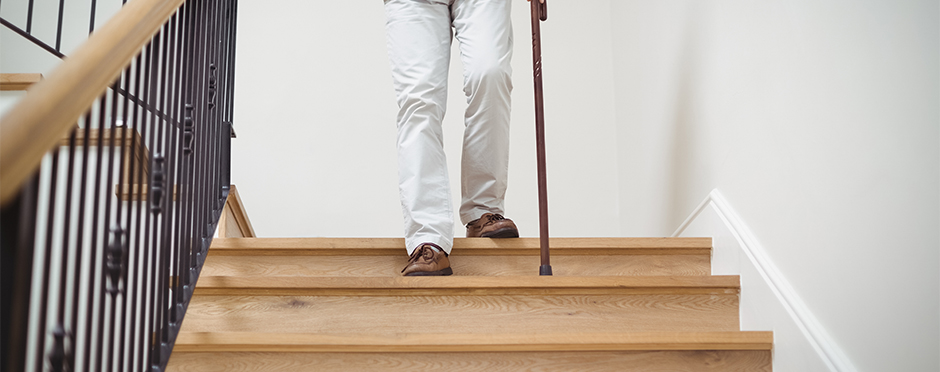
Tips From A PT: 8 Ways To Prevent Falling On Stairs
1 CommentFalls can occur anywhere at any time, especially when going up and down flights of stairs. Regardless of age or ability, everyone can practice fall prevention to avoid injuries in and out of the home. Looking for a way to keep you or a loved one safe at home? Here is a list of some ways to reduce the risk of falls and injuries on stairs.
“Expect The Best, Plan For The Worst”
A fall down a flight of stairs can be a traumatic and sometimes fatal occurrence. It is therefore important to plan ahead to ensure you or your loved one’s safety. Preparing a chair, or a rest area at the top and bottom (and middle if able) allows individuals to catch their breath and rest if needed. It may not be used, but it’s better to be prepared than to take a tumble.
Plan Ahead
If you typically use a cane, crutches, walker, or other assistive device it can be useful to plan ahead. If you keep a spare cane, pair of crutches or walker at the top or bottom of the staircase, you will no longer need to carry it as you make your journey. This will allow you to more safely ascend or descend the stairs clutter free.
Safety First!
When was the last time the stairs and/or railings were inspected? Most public venues are handicap accessible, but if you are visiting a friend in an old house or apartment it may be wise to make sure the railings can support your weight or are affixed to the wall properly. You can never be too safe, especially if you are planning a large gathering with elderly or frail clientele.
Get Creative
If you’re at the top of the stairs with a heavy, large and soft item that you need to carry down, why not toss it to the bottom? This can be done with laundry, sheets, or even stuffed animals and toys. In order to safely utilize handrails, it is important to have free hands. Although this technique may not work with all items, it’s important to remember the “usual way” isn’t always the best way. This may mean wearing a jacket down the stairs, instead of carrying it or even placing a fragile item in a bag and wearing it on your back in order to keep your hands free.
Efficiency Is The Key To Success
Why go up and down a flight of stairs ten times in a day to put “one thing away”, when you can plan ahead and make one trip with all ten items? The best way to do this is to place a small box or bag at the base or top of the stairs. Slowly spend the day filling it with items you need to relocate, and when it is full or of safe size, you can make one safe and effective trip. This will help reduce excessive fatigue and shortness of breath; it can also conserve energy for the rest of your day.
Don’t Forget About Lighting
As we age, our vision and perception of light declines. It is important to maintain bright lighting and good visual contrast to reduce risk of slips, trips, and falls. One other alternative to the use of lights, is to utilize bright or neon tape on the edge of the steps to provide a great visual contrast to ensure the individual can clearly differentiate between the steps. If there is a true visual impairment, then a tactile non-slip tape or change in surface material can ensure the individual can safely anticipate the change in gradient ahead of them.
Block Of Fall Hazards
The worst type of fall is an unexpected fall. This can be avoided with use of gates at the top and/or bottom of the stairwell. “Baby gates” as they are typically refereed to, can also help prevent accidental missteps or loss of balances when we least expect it. It is also a good reminder to both slow down and pace yourself prior to quickly descending or ascending a flight of stairs. There is no need to rush up and down stairs, instead take your time and avoid injury so you can enjoy the rest of your day.
Give Visual Grounding A Try
Vertigo is a term that often gets tossed around when people feel dizzy when they are hiking, climbing or even flying high up in the air. However, even a few steps can be quite intimidating for some. One technique, called visual grounding, can help people feel more stable and confident on their feet when they feel dizzy or off balance. By gazing at a non-moving object (such as an outlet, handrail, or light switch) while you are in movement; we do this to train our brains to feel safe, steady, and reduce risk of falls.
This list highlights a few simple solutions to help you and your loved ones stay safe in and outside of the home. For a more patient-specific and individualized plan, please reach out to Athletico and set up a free assessment for you or your loved one. Free Assessments are available in-clinic and virtually through our Telehealth platform.
*Per federal guidelines, beneficiaries of plans such as Medicare, Medicaid, Tricare, VHA and other federally funded plans are not eligible for free assessments.
The Athletico blog is an educational resource written by Athletico employees. Athletico bloggers are licensed professionals who abide by the code of ethics outlined by their respective professional associations. The content published in blog posts represents the opinion of the individual author based on their expertise and experience. The content provided in this blog is for informational purposes only, does not constitute medical advice and should not be relied on for making personal health decisions.

1 Comment
Anthony Adkins
How do you regain lost energy.
Age 81, 50 year vegan, 5year vegetarian, (fish & dairy).